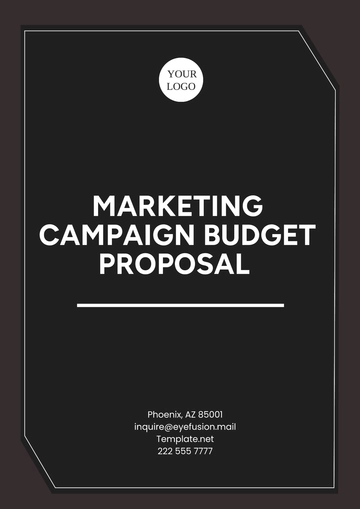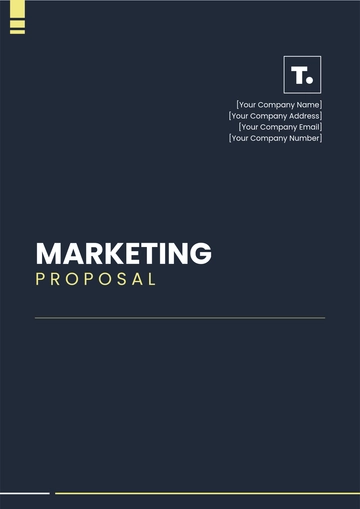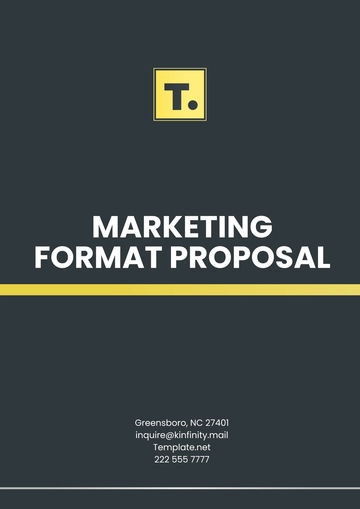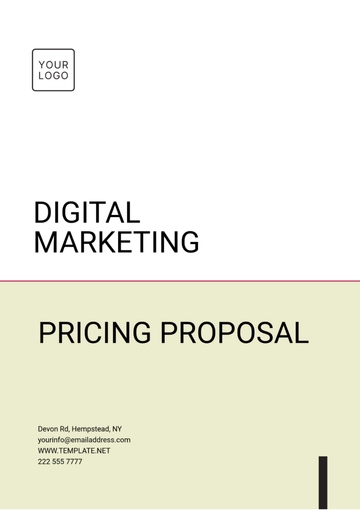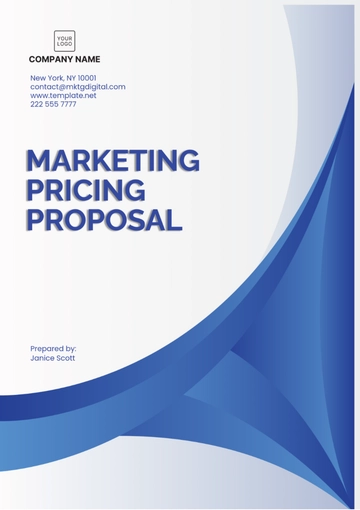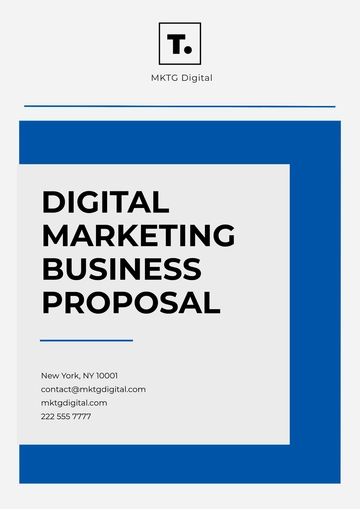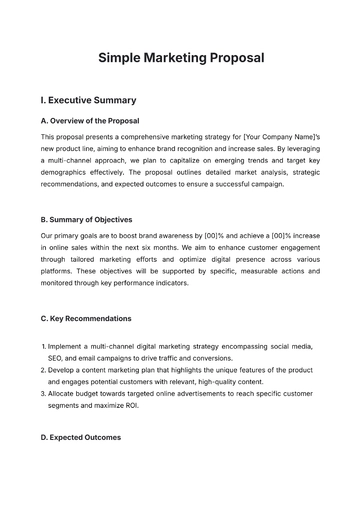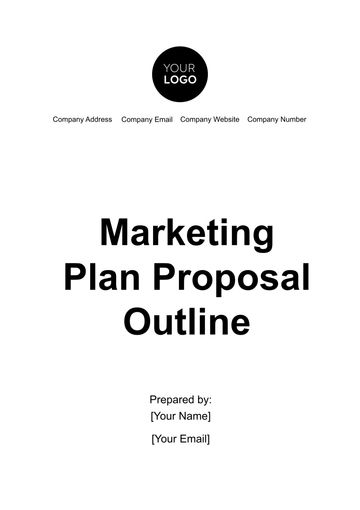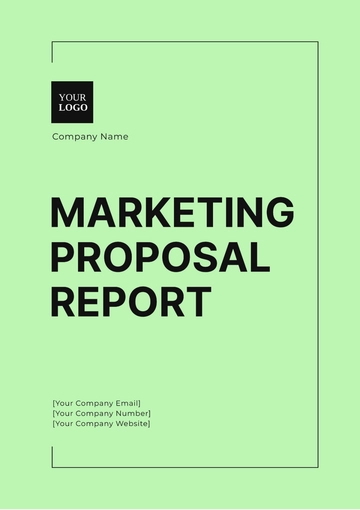Free Marketing Budget Reallocation Proposal

INTRODUCTION
In an ever-evolving business landscape, the effective management of our marketing budget is paramount to sustain growth and adapt to market dynamics. At [Your Company Name], we understand the significance of aligning our resources with strategic objectives. This Marketing Budget Reallocation Proposal is a response to changing market conditions and the need to optimize our marketing budget to maximize our return on investment.
Our goal is not merely cost-cutting but to ensure that each dollar spent generates the best possible results. This proposal outlines the rationale and strategy behind the reallocation of our marketing budget and aims to provide transparency and insight into our decision-making process.
CURRENT BUDGET ALLOCATION
To better understand the proposed reallocation, it's essential to have a clear picture of our existing budget allocation. Our marketing budget for the current fiscal year is distributed across various key areas:
1. Advertising and Promotion
This category accounts for $[000,000], which includes expenses related to traditional advertising methods, such as print media and billboards.
2. Digital Marketing
Our digital marketing efforts are allocated $[00,000], covering activities like online advertising, social media campaigns, and content promotion.
3. Trade Shows and Events
We allocate $[00,000] for participation in trade shows, conferences, and industry events, where we showcase our products and services.
4. Content Creation
A total of $[00,000] is set aside for content creation, which includes costs related to the production of blog posts, videos, and other promotional materials.
5. Personnel
A substantial portion of our budget, $[000,000], is dedicated to personnel, covering salaries, benefits, and training for our marketing team.
6. Miscellaneous
Finally, we allocate $[00,000] for miscellaneous expenses, which encompass unforeseen costs and other marketing-related expenditures.
When visualized in a chart, this is how it would look like:
1. Advertising and Promotion:
a. The largest segment of the pie is allocated to advertising and promotion.
b. This category includes expenses related to traditional advertising methods, such as print media and billboards.
c. It signifies a significant investment in traditional marketing channels to promote the company's products and services.
2. Personnel:
a. The second-largest segment is allocated to personnel.
b. This category covers expenses related to the marketing team's salaries, benefits, and training.
c. It reflects a substantial commitment to human resources, indicating a well-staffed and skilled marketing team.
3. Digital Marketing:
a. Digital marketing holds a notable portion of the budget, at 18.6%.
b. This category includes expenses for online advertising, social media campaigns, and content promotion.
c. It reflects the company's recognition of the importance of digital marketing in reaching and engaging with the target audience.
4. Content Creation:
a. Content creation receives 14% of the budget allocation.
b. This category encompasses expenses associated with producing content such as blog posts, videos, and promotional materials.
c. It signifies the investment in creating valuable and engaging content for marketing purposes.
5. Trade Shows and Events:
a. Trade shows and events are allocated [00]% of the budget.
b. This category covers the costs of participating in industry events, conferences, and trade shows.
c. It suggests the company's engagement in face-to-face marketing and networking opportunities.
6. Miscellaneous:
a. The smallest segment represents miscellaneous expenses and accounts for [0]% of the budget.
b. This category covers unforeseen or miscellaneous marketing-related costs.
c. It signifies a minor but essential allocation for unexpected expenses.
PROPOSED BUDGET REALLOCATION
Rationale
Recent market analysis, coupled with a review of our past marketing performance, reveals that digital marketing initiatives have consistently delivered better results and a higher return on investment. This data-driven decision is supported by the shifting consumer landscape, which increasingly relies on online platforms. Therefore, it's prudent to reallocate resources to this channel to optimize our marketing efforts and ensure our marketing budget is effectively leveraged for the best possible outcome.
Adjusted Allocation
Proposed Budget Reallocation:
Advertising and Promotion: $[000,000]
Decreasing the budget slightly will help maintain our market presence while redirecting funds to the more cost-effective digital channels.
Digital Marketing: $[000,000]
Increasing the budget allocation for digital marketing allows us to strengthen our online presence, invest in pay-per-click campaigns, and leverage social media advertising.
Trade Shows and Events: $[00,000]
A modest reduction here is in line with our market analysis, while still enabling us to participate in key industry events.
Content Creation: $[00,000]
A slight increase is proposed to improve content quality and relevance.
Personnel: $[00,000]
This reduction can be achieved by streamlining operations and cross-training team members.
Miscellaneous: $[00,000]
This budget remains virtually unchanged, providing flexibility for unforeseen marketing opportunities.
Here’s how the reallocated budget would look like in a pie chart:
IMPACT ASSESSMENT
Expected Outcomes
Anticipated outcomes are a strengthened digital presence, higher ROI, and better cost-efficiency. With increased investment in digital marketing, we expect to see a significant rise in website traffic, lead generation, and conversions. The adjusted budget will help us align our marketing efforts with the evolving consumer behavior and emerging market trends, leading to sustainable growth and a stronger market position.
Mitigation Plan
While the proposed reallocation is expected to enhance our marketing effectiveness, we recognize that a transition to a more digital-focused strategy might require additional training for our marketing team. We have planned for a phased approach to the budget reallocation, which will allow for a gradual shift in marketing activities. Furthermore, we will provide additional training and resources to ensure that the team is well-equipped to optimize our digital marketing efforts. Our goal is to minimize any potential risks associated with the reallocation, making it a smooth and successful transition for the entire marketing team.
IMPLEMENTATION PLAN
Timeline
The reallocation will commence in [Month Year] and span over the course of three months, with a completion target set for [Month Year]. This gradual implementation allows for a smooth transition without disrupting ongoing marketing efforts.
Responsibilities
The success of this budget reallocation is contingent on a collaborative effort among key team members. The following roles and responsibilities will guide the implementation:
Mike Smith (Marketing Director): Mike will serve as the project lead, responsible for overseeing the entire process. His duties include formulating the implementation plan, coordinating with department heads, and ensuring adherence to the new allocation structure.
Marketing Team: This cross-functional team will be divided into specialized sub-teams focused on specific marketing activities. Each sub-team will adapt to the revised budget allocation as per their assigned area and work closely with John to ensure a seamless transition.
Finance Department: The finance team will play a vital role in overseeing the actual financial transactions related to the reallocation. They will be responsible for distributing the budget to the various marketing activities based on the revised allocation.
External Consultants: As needed, external consultants may be brought in to provide specialized knowledge and training, especially in optimizing digital marketing efforts. Their role is to facilitate the skill enhancement required for a successful transition.
It is crucial that all team members are well-informed about their roles and responsibilities during the reallocation process. Regular communication and status updates will be an integral part of the implementation strategy, ensuring that all activities align with the proposed budget adjustments.
MONITORING AND EVALUATION
Key Performance Indicators (KPIs)
To effectively assess the impact of the proposed budget reallocation, we will closely monitor and measure key performance indicators (KPIs) on an ongoing basis. These KPIs will be aligned with our objectives and include:
Digital Reach: We will track the expansion of our digital presence by monitoring metrics such as website traffic, social media engagement, and email open rates. This will help us gauge the effectiveness of reallocating resources to digital marketing.
Conversion Rates: To evaluate the impact on lead generation and sales, we will closely follow conversion rates across various digital marketing channels. We will measure the rate at which website visitors become leads or customers.
Cost per Acquisition (CPA): Assessing the efficiency of our marketing spend is essential. By calculating the CPA for different channels, we can determine the cost-effectiveness of our advertising and promotional efforts.
Regular Reporting
To ensure transparency and keep stakeholders informed of our progress, we will implement a structured reporting process. This will include:
Monthly Progress Reports: These will provide an overview of our performance based on the defined KPIs. Any significant findings or trends will be highlighted for further analysis and decision-making.
Quarterly Reviews: Every three months, we will conduct a comprehensive review of the reallocation's impact. This review will include in-depth insights, a summary of budget utilization, and any necessary adjustments for the upcoming period.
Ad Hoc Reports: In the event of notable developments or changes in the marketing landscape, we will provide ad hoc reports to address any emerging issues or opportunities.
Executive Summaries: Regular executive summaries will be presented to the leadership team, summarizing the progress, results, and any recommended actions for optimizing our marketing budget.
CONCLUSION
The proposed budget reallocation represents a strategic decision to adapt to evolving market dynamics and enhance the efficiency and effectiveness of our marketing efforts. By shifting resources to digital marketing, we anticipate a more significant digital presence, increased ROI, and improved cost-efficiency.
This move not only aligns with current market trends but also positions [Your Company Name]. to stay ahead of the competition. It recognizes the growing impact of digital channels and acknowledges the changing preferences of our target audience. It is a proactive measure to remain relevant and deliver value to our customers.
The success of this reallocation will depend on effective execution and continuous monitoring of key performance indicators. Our commitment to data-driven decision-making, regular reporting, and flexibility in response to emerging trends will be instrumental in achieving our objectives.
We appreciate the dedication and hard work of our marketing team, which is crucial in implementing this strategic shift successfully. We remain confident in their abilities to adapt to this new direction and create meaningful, data-backed marketing strategies.
In the ever-evolving landscape of marketing, it is imperative that [Your Company Name]. remains agile and open to change. This budget reallocation is a proactive step in that direction. It underscores our commitment to delivering value, maintaining a strong market position, and ultimately ensuring the growth and success of our organization.
Date: [Month Day, Year]
- 100% Customizable, free editor
- Access 1 Million+ Templates, photo’s & graphics
- Download or share as a template
- Click and replace photos, graphics, text, backgrounds
- Resize, crop, AI write & more
- Access advanced editor
Introducing our Marketing Budget Reallocation Proposal Template, meticulously crafted to optimize your marketing strategies. Created by industry experts at Template.net, this editable and customizable template seamlessly integrates your keywords for enhanced targeting. Utilize our AI Editor Tool to streamline your proposal process and achieve unparalleled efficiency in your marketing endeavors.
You may also like
- Business Proposal
- Research Proposal
- Proposal Request
- Project Proposal
- Grant Proposal
- Photography Proposal
- Job Proposal
- Budget Proposal
- Marketing Proposal
- Branding Proposal
- Advertising Proposal
- Sales Proposal
- Startup Proposal
- Event Proposal
- Creative Proposal
- Restaurant Proposal
- Blank Proposal
- One Page Proposal
- Proposal Report
- IT Proposal
- Non Profit Proposal
- Training Proposal
- Construction Proposal
- School Proposal
- Cleaning Proposal
- Contract Proposal
- HR Proposal
- Travel Agency Proposal
- Small Business Proposal
- Investment Proposal
- Bid Proposal
- Retail Business Proposal
- Sponsorship Proposal
- Academic Proposal
- Partnership Proposal
- Work Proposal
- Agency Proposal
- University Proposal
- Accounting Proposal
- Real Estate Proposal
- Hotel Proposal
- Product Proposal
- Advertising Agency Proposal
- Development Proposal
- Loan Proposal
- Website Proposal
- Nursing Home Proposal
- Financial Proposal
- Salon Proposal
- Freelancer Proposal
- Funding Proposal
- Work from Home Proposal
- Company Proposal
- Consulting Proposal
- Educational Proposal
- Construction Bid Proposal
- Interior Design Proposal
- New Product Proposal
- Sports Proposal
- Corporate Proposal
- Food Proposal
- Property Proposal
- Maintenance Proposal
- Purchase Proposal
- Rental Proposal
- Recruitment Proposal
- Social Media Proposal
- Travel Proposal
- Trip Proposal
- Software Proposal
- Conference Proposal
- Graphic Design Proposal
- Law Firm Proposal
- Medical Proposal
- Music Proposal
- Pricing Proposal
- SEO Proposal
- Strategy Proposal
- Technical Proposal
- Coaching Proposal
- Ecommerce Proposal
- Fundraising Proposal
- Landscaping Proposal
- Charity Proposal
- Contractor Proposal
- Exhibition Proposal
- Art Proposal
- Mobile Proposal
- Equipment Proposal
- Student Proposal
- Engineering Proposal
- Business Proposal

